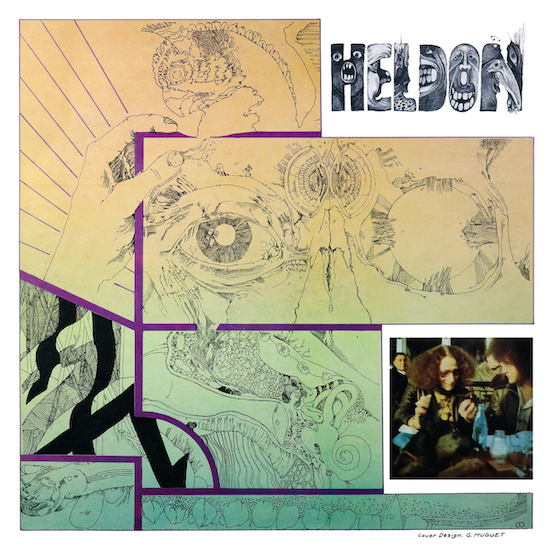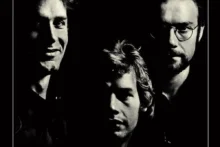The title might have a nice ring to it, but Electronique Guerilla was also a statement of intent when Heldon released it in 1974. The word “electronique” would have been relatively new in the context of music, and might have even needed explaining to anyone hearing this debut album for the first time, though 50 years later, most people will have at least some idea of what electronic music is.
With the word “guerilla” there’s more to unpack. Less fashionable than its usage once was, the OED defines it as: “An irregular war carried out by small bodies of men acting independently.” Heldon was a sonic cell waging a metaphorical war upon the senses, and their independence would have been highly unusual at the time. Head of these sonic insurgents was Richard Pinhas, an outlier putting electronic music into the world in defiance of an elitist system in France. It was essentially a war fought on two fronts.
Firstly, the French music industry was even more of a closed shop than the US or the UK in the mid-70s. A&R departments worked within a smaller ecosystem of labels like Barclay, Disques Vogue and Pathé, with the gatekeepers of entertainment making a career in music almost impossible without their say so. Claude François or Françoise Hardy would be paired up with arrangers, producers and co-writers, with a lack of creative autonomy and little say beyond the whims of the labels and the fashions of the time.
Secondly, electronic music was the preserve of academia in the early 70s in France, emerging from the musique concrète experiments of Pierre Schaeffer. There was the odd aberration, such as the ondioline player Jean-Jacques Perrey, who would have largely been regarded as a novelty, and Pierre Henry, who worked with the forward-thinking Michel Colombier, though Henry had been in cahoots with Schaeffer at the Groupe de Recherches Musicales (GRM) before attempting to break into the mainstream with tracks like ‘Psyché Rock’.
High-minded sonic investigations were not primarily intended for wider consumption, which is why Jean-Michel Jarre – who’d become disillusioned with academia in 1968 – recorded what would become the 7” release ‘La Cage’/ ‘Erosmachine’ in the dead of night at the GRM with the blinds drawn. As Jarre told me when I interviewed him for Electronic Sound in 2022: “As students, we were not allowed to go alone into the big professional studios. Established composers could use them and they were locked. And I remember that we as students made a copy of the key to go inside the studio at night. And the entirety of ‘La Cage’ and its sequences had to be done at night with no lighting in the studio because we were not allowed to be there.”
Ironically, Pinhas was an academic, though not in the field of music. As a philosophy student at the Sorbonne, he became good friends with his lecturer Gilles Deleuze, so much so that Deleuze recorded with him – firstly on the 7” single ‘La Voyageur’ (recorded by Pinhas under the name Schizo) reading a spoken word passage from Nietzsche’s The Wanderer And His Shadow: “He who has attained the freedom of reason to any extent cannot, for a long time, regard himself otherwise than as a wanderer on the face of the earth." This was in keeping with Pinhas’ zeal for knowledge as a student in his early 20s, drinking in the words of many of the greatest philosophers of the 20th century (he would have also encountered Foucault, Baudrillard and Lyotard by this point). The track was re-recorded for Electronique Guerilla, this time under the title ‘Ouais, Marchais, Mieux Qu’en 68’.
The label that released this single, Disjuncta, was owned by Pinhas, and it was arguably the first fully independent rock label in France. Avant-garde jazz labels had come before, namely Saravah, inaugurated by Pierre Barrouh in 1965, and BYG with its Actuel series inaugurated in 1968, releasing music by American artists such as Don Cherry, but Disjuncta wasn’t really avant-garde, even if it was at the vanguard of future music. The intention was to reach people, and reach people they did.
Before DIY culture, before Buzzcocks’ Spiral Scratch and before the self-released music of Throbbing Gristle, Electronique Guerilla sold something in the region of 19,000 copies, completely independent of the usual channels – not bad for a piece of "autoproduit" (the Spinal Scratch EP was estimated to have sold around 16,000). In that sense, Heldon’s debut album can be seen as an act of provocation that preceded the British punk explosion by a couple of years. That it paved the way for Pete Shelley, Richard Boon and Howard Devoto’s New Hormones label or Throbbing Gristle’s Industrial Records is unlikely, as the British artists would almost certainly not have known about Disjuncta. It instead indicates a wider contemporaneous discontent, where young musicians were seizing the means of production in more regions than we generally acknowledge, not to take away from the importance of Spiral Scratch and its catalytic effect in the UK.
The germ of an idea which became Electronique Guerilla had actually come to Pinhas in 1972, when he’d gone to see King Crimson play live in London, though it was the strange ambient warmup music that had turned his head rather than the show itself. It would later transpire to be a pre-release mix of the forthcoming (No Pussyfooting) by Fripp and Eno. The Frenchman became obsessed with the idea of trying to recreate this amalgam of sustained, simmering guitar vapour and the singular, atmospheric electronic accompaniment, which certainly comes nicely to fruition on tracks like ‘Circulus Vitiosus’ on Electronique Guerilla.
It served as an inspiration, though Heldon would move further away from that blueprint on each successive release, with 1977’s explosive Interface absorbing elements of space rock and free jazz. As Pinhas said in 2019: “Of course I was blown away by Fripp. But although I have influences, I’ve never tried to make a copy of anything.” Therefore, Electronique Guerilla, created from a fleeting audio memory that would have quickly faded – compounded by a bracing two hours of King Crimson immediately afterwards – has traces of elements half remembered and maybe scrawled onto a packet of Gauloises. There are vestiges but it’s also very much its own beast.
Pinhas was building a studio at home at the time of this epiphany (unheard of then, and still regarded an anomaly when Jean-Michel Jarre recorded Oxygène in his kitchen in 1976). He bought a VCS3, the same instrument played by Eno on (No Pussyfooting), and a pair of EMS AKS machines that Heldon could take on tour. The synths were played by Patrick Gauthier or Georges Grünblatt, with Pinhas usually decorating the sound with lines of sustained guitar.
Such an outlay was certainly more than most students could afford, and questions have sometimes been asked about how Pinhas financed the operation. In truth, the nest egg he received intended for his studies would have been a lot of money at the time, but not a life-changing amount of money. In more recent years, he’s often expressed the folly of his decision to pursue rock & roll rather than academia, which would have been far more comfortable in the long run.
“My parents were not rich, but they were rich enough to pay me through my studies without me having to work. I think it’s important to state that,” he told me when I interviewed him for Huck in 2022. “I was lucky enough that I had enough money to live, and then you can start to do the things you want to do.” Electronique Guerilla is the result of that good fortune and some savvy choices – creatively speaking, anyway. Its 33 revolutionary minutes put two fingers up at the French music industry and the electronic avant-garde. Heldon’s ongoing reissue campaigns in recent years have been received with widespread acclaim, though Pinhas’ role as an iconoclast, agitator and a force for change is not discussed nearly enough.
Electronique Guerilla is out now on Bureau B




